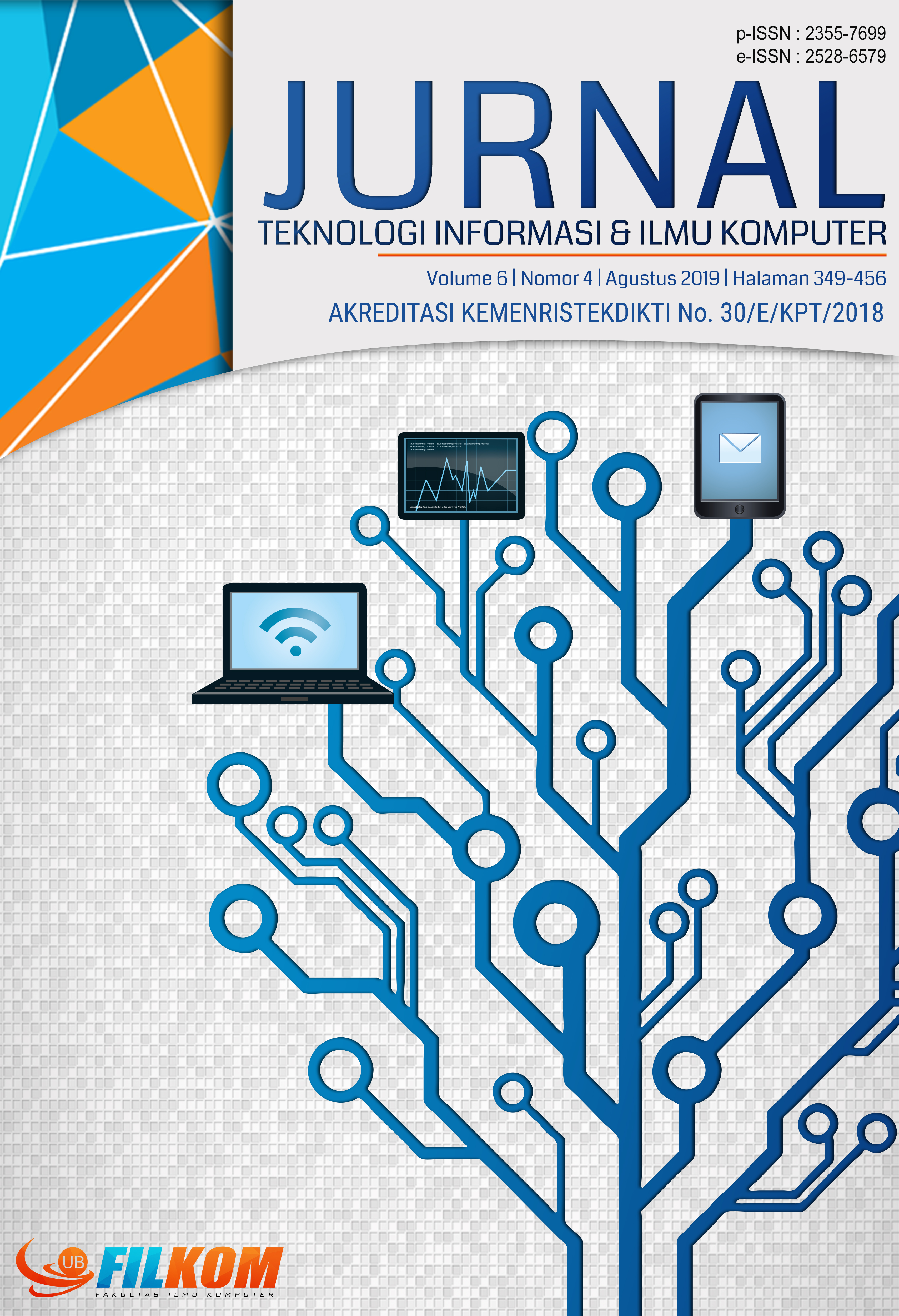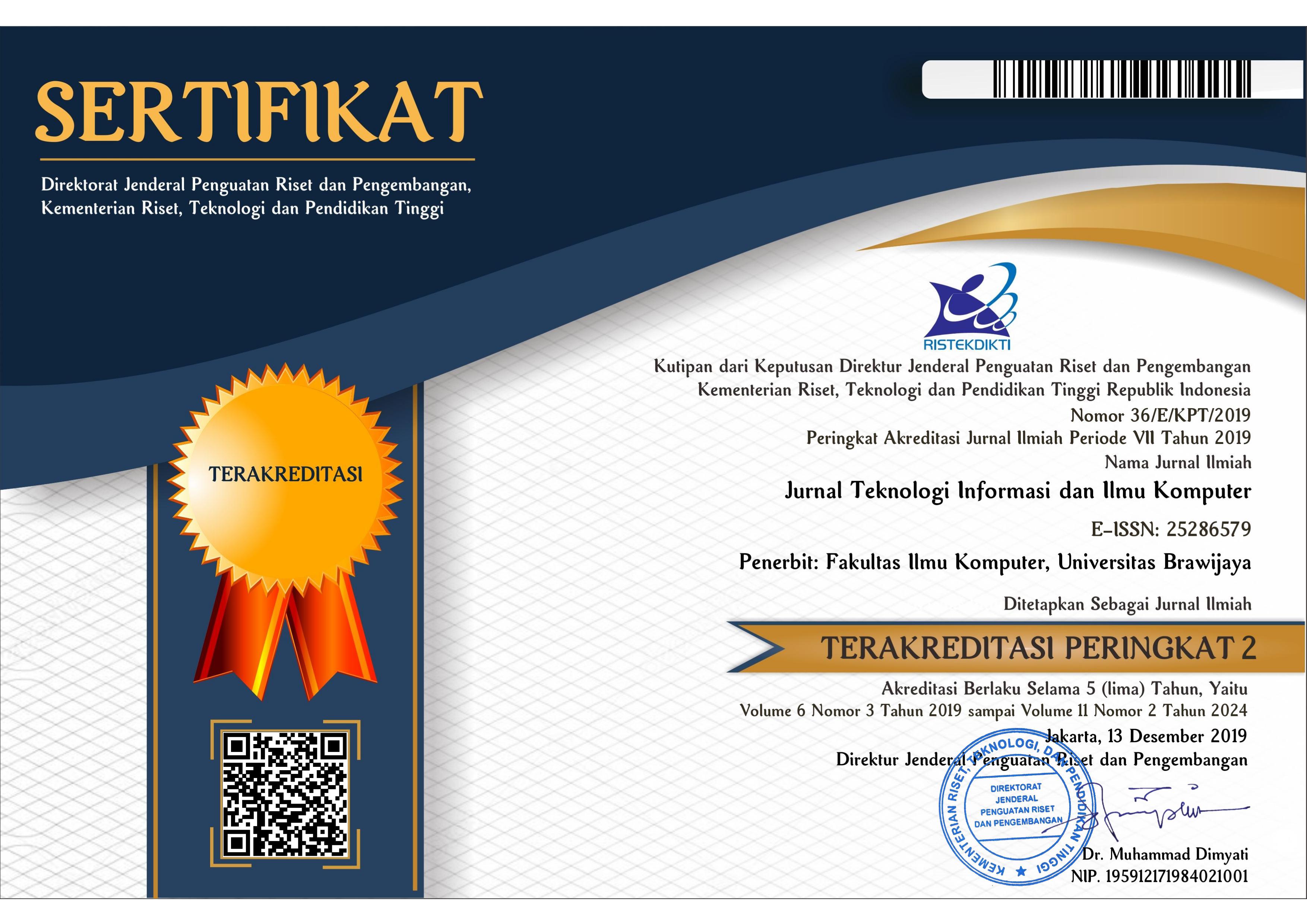Pengendali Suhu pada Proses Pasteurisasi Susu dengan Menggunakan Metode PID dan Metode Fuzzy Sugeno
DOI:
https://doi.org/10.25126/jtiik.2019641068Kata Kunci:
pasteurisasi, low temperature long time, proportional-integral-derivative, sistem fuzzyAbstrak
Proses pasteurisasi berfungsi untuk membunuh bakteri patogen yang dapat mengganggu kesehatan. Selain itu proses pasteurisasi juga bermanfaat untuk memperpanjang masa susu tidak rusak sehingga kualitas susu dapat dipertahankan sampai jangka waktu tertentu. Pada penelitian pengabdian masyarakat ini proses pasteurisasi susu dengan model low temperature long time (LTLT) dibangun dengan menggunakan pengendali PID dan pengendali Fuzzy. Model LTLT dipilih karena adanya kebutuhan masyarakat untuk dapat mencampur susu dengan berbagai perasa selama proses pasteurisasi berlangsung. Tujuan akhir dari penambahan perasa pada susu adalah untuk meningkatkan daya jual dari susu pasteurisasi. Berdasarkan hasil pengujian didapatkan bahwa sistem pengendali PID dengan nilai K_P=31,8; K_I=117,8; K_D=4,3 memberikan respon lebih cepat daripada sistem pengendali Fuzzy berdasarkan pengukuran indikator waktu tunda, waktu naik, waktu puncak dan waktu penetapan. Sebaliknya sistem pengendali Fuzzy menghasilkan nilai MSE lebih kecil daripada sistem pengendali PID yang menunjukkan bahwa sistem pengendali Fuzzy lebih akurat daripada sistem pengendali PID dalam proses pasteurisasi susu. Hasil pengujian laboratorium terhadap susu hasil proses pasteurisasi menunjukkan bahwa jumlah cemaran mikroba telah turun pada jumlah sesuai dengan standar SNI pada saat yang sama kualitas susu hasil proses pasteurisasi tetap terjaga.
Abstrack
Milk pasteurization process has benefit for reducing pathogenic bacteria that may harm people’s health. At the same time, this process can be used to maintain the milk quality for long period of time. In this research, a milk pasteurization process that based on the low temperature long time (LTLT) was built utilizing the Proportional-Integral-Derivative and the Fuzzy system methods. The LTLT method was chosen in this project due to the need to blend the pasteurized milk with several type of food flavoring to increase the selling power of the pasteurized milk. Therefore, it needs longer pasteurization time. Based on the 30 trials of examination, it showed that the PID controller with values of was able to provide a faster system response time compared to the Fuzzy controller. The measurement was done utilizing several indicators including delay time, rise time, peak time as well as settling time. In contrast, the Fuzzy controller produced a smaller mean squared error (MSE) compared to the PID controller showing that the Fuzzy controller produced smaller error fluctuation in the milk pasteurization process. Nevertheless, the results showed that both controllers exhibited MSE lower than , it indicates that both controllers could maintain milk temperature at the range of the standardized milk pasteurization process. Moreover, laboratory examination showed that using both pasteurization methods the number of coliform bacteria have been decreased to meet with the SNI standard and at the same time it was able to maintain the quality of the milk.
Downloads
Referensi
ALAMIREW, T., BALAJI, V. dan GABBEYE, N., 2017. Comparison of PID controller with model predictive control for milk pasteurization process. Bulletin of Electrical Engineering and Informatics, 6(1), p. 24-35.
ANANG, HADISUPADMO, S, dan LEKSONO, E., 2016. Model predictive control design and performance analysis of a pasteurization process plant. Prosiding International Conference on Instrumentation, Control and Automation (ICA), Bandung, Indonesia.
ATMEL, 2002. 8-bit AVR Microcontroller with 16K Bytes In-System Programmable Flash. San Jose, California, USA: ATMEL.
ICHSAN, M.H.H., SETIAWAN, E. dan HAMIDI, M.A., 2016. Implementasi logika fuzzi pada sistem berbasis field programmable gate array (FPGA). Jurnal Teknologi Informasi dan Ilmu Komputer, 3(1), p. 75-82.
MAULANA, Y. Z., HADISUPADMO, S, dan LEKSONO, E., 2016. Performance analysis of PID controller, Fuzzy and ANFIS in pasteurization process. Prosiding International Conference on Instrumentation, Control and Automation (ICA), Bandung, Indonesia.
MAXIM INTEGRATED PRODUCTS, 2015. Programmable resolution 1-wire digital thermometer. San Jose, California, USA: Maxim Integrated Products, Inc.
OGATA, K., 2010. Modern Control Engineering. 5th ed. Upper Saddle River, NJ, USA: Prentice Hall.
POUR, F.K., PUIC, V., dan MARTINEZ, C.O., 2017. Comparative assessment of LPV-based predictive control strategies for a pasteurization plant. Prosiding International Conference on Control, Decision and Information Technologies (CoDIT), Barcelona, Spain.
RESNAWATI, H., 2008. Kualitas susu pada berbagai pengolahan dan penyimpanan. Prosiding seminar nasional prospek industri sapi perah menuju perdagangan bebas – 2020, Jakarta, [e-proceeding]. Tersedia di < http://perpustakaan-puslitbangnak.blogspot.com/2014/12/prosiding-prospek-industri-sapi-perah.html > [diakses pada 30 Juli 2018]
SALEH, E., 2004. Teknologi pengolahan susu dan hasil ikutan ternak. Medan: USU Digital Library, [e-journal]. Tersedia melalui: Perpustakaan Universitas Sumatra Utara < http://library.usu.ac.id/download/fp/ternak-eniza.pdf> [Diakses 30 Juli 2018]
SETYAWAN, G.E., SETIAWAN, E. dan KURNIAWAN, W., 2015. Sistem kendali ketinggian quadcopter menggunakan PID. Jurnal Teknologi Informasi dan Ilmu Komputer, 2(2), p. 125-131.
SRISUMA, C., SANTALUNA, S., THOSDEEKORAPHAT, T., dan THONGSOPA, C., 2017. The analysis and design of milk pasteurization system by using radio frequency electric fields. Prosiding Asia-Pacific International Symposium on Electromagnetic Compatibility, Seoul, Korea.
SUWITO, W., 2010. Bakteri yang sering mencemari susu: deteksi, patogenesis, epidemiologi, dan cara pengendaliannya. Jurnal Litbang Pertanian, 29(3), p. 96-100.
Unduhan
Diterbitkan
Terbitan
Bagian
Lisensi

Artikel ini berlisensi Creative Common Attribution-ShareAlike 4.0 International (CC BY-SA 4.0)
Penulis yang menerbitkan di jurnal ini menyetujui ketentuan berikut:
- Penulis menyimpan hak cipta dan memberikan jurnal hak penerbitan pertama naskah secara simultan dengan lisensi di bawah Creative Common Attribution-ShareAlike 4.0 International (CC BY-SA 4.0) yang mengizinkan orang lain untuk berbagi pekerjaan dengan sebuah pernyataan kepenulisan pekerjaan dan penerbitan awal di jurnal ini.
- Penulis bisa memasukkan ke dalam penyusunan kontraktual tambahan terpisah untuk distribusi non ekslusif versi kaya terbitan jurnal (contoh: mempostingnya ke repositori institusional atau menerbitkannya dalam sebuah buku), dengan pengakuan penerbitan awalnya di jurnal ini.
- Penulis diizinkan dan didorong untuk mem-posting karya mereka online (contoh: di repositori institusional atau di website mereka) sebelum dan selama proses penyerahan, karena dapat mengarahkan ke pertukaran produktif, seperti halnya sitiran yang lebih awal dan lebih hebat dari karya yang diterbitkan. (Lihat Efek Akses Terbuka).








